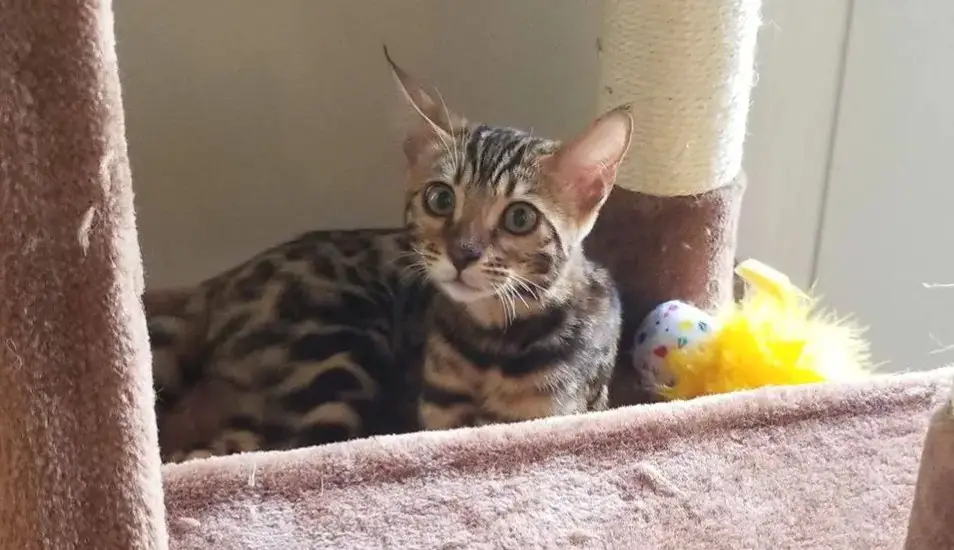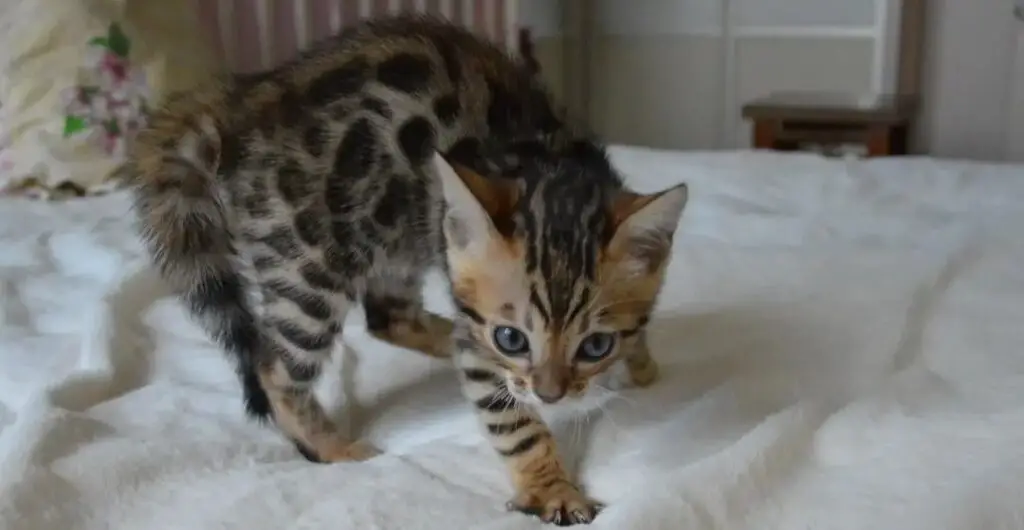Let’s talk about the common behaviors of adopted stray cat, I can tell you that understanding these behaviors will help you and your adopted stray cat live a happy life.
Depending on the circumstances that made the cat become a stray cat, stray cats can exhibit a different range of behaviors according to their personalities.
In this post, I’ll share some of the most common behaviors of adopted stray cats and how to help them adjust to their new home, keep reading to find out more…
Behaviors of Adopted Stray Cat
Based on the information I gathered from people who actually adopted stray cats, here are some common behaviors of adopted stray cats you should know:
1. Hiding and seeking safe spaces

When a stray cat first enters a new environment, I believe they will feel overwhelmed and anxious based on the information I gathered.
It’s also natural for stray cats to seek out hiding spots where they can feel secure, these safe spaces could be under furniture, in closets, or behind curtains.
You may notice that your new feline friend spends a lot of time in these areas, especially during the initial days or weeks after adoption.
To identify this behavior in newly adopted stray cats, watch for signs such as a sudden disappearance or a reluctance to come out even when called.
Adjusting to this behavior involves creating a safe and comfortable environment for your cat.
I recommend you provide hiding places like cat trees, boxes, or cozy blankets in quiet areas of your home.
You should also gradually introduce your newly adopted cat to new spaces, allowing them to explore at their own pace.
2. Shyness and fearfulness
Stray cats often have a history of uncertainty and will exhibit shyness and fearfulness when introduced to new people or environments.
Based on the information I gathered about adopted stray cats, they will cower, flatten their bodies close to the ground, or even hiss or growl when they feel threatened or scared.
It’s important to remember that these behaviors are a result of their past experiences before they were adopted.
Identifying shyness and fearfulness in your newly adopted stray cat involves observing your cat’s body language.
You should look for signs of tension, such as dilated pupils, flattened ears, or a tucked tail.
Adjusting to this behavior requires patience and a gentle approach, therefore, you should give your adopted stray cat space and time to acclimate to their new surroundings.
You must avoid forcing interactions and instead let them approach you when they feel comfortable.
You should also provide positive reinforcement, like treats or gentle praise, to encourage trust.
3. Exploration and investigation
Stray cats are naturally curious creatures and have a strong instinct to investigate their surroundings.
When they feel safe and secure, they will start exploring, sniffing, and pawing at objects.
This behavior is a positive sign that your cat is becoming more comfortable in their new home.
To identify this behavior, you should observe your adopted stray cat’s interest in their surroundings.
Are they inspecting new items, climbing on furniture, or investigating nooks and crannies?
Adjusting to this behavior involves creating an enriching environment for your newly adopted stray cat.
You should provide scratching posts, interactive toys, and vertical spaces for climbing.
You must supervise their exploration to ensure their safety and redirect any unwanted behaviors, like scratching furniture.
Related: How to entertain a bored cat.
4. Slow adjustment to new surroundings
When a stray cat enters a new environment, it usually takes them some time to feel comfortable and secure.
They may be cautious and hesitant, spending most of their time observing their surroundings rather than actively exploring.
This slow adjustment is completely normal and stems from their instinct to assess potential threats.
To identify this behavior, observe your adopted cat’s initial response to their new surroundings. Are they staying in one area, hiding, or avoiding interactions?
Adjusting to this behavior involves creating a calm and safe environment for your adopted cat.
You should also provide hiding spots, like cozy beds or covered cat condos, where they can retreat when they feel overwhelmed.
You should also gradually introduce new spaces and experiences, allowing them to explore at their own pace.
5. Increased vigilance and alertness

Stray cats have honed their survival instincts while living on the streets, making them naturally vigilant and alert.
When adopted, they will always exhibit heightened awareness of their surroundings.
They will constantly scan the environment, maintain a wide-eyed expression, and react to even the slightest sounds or movements.
To identify this behavior in your newly adopted stray cat, you should pay attention to your adopted cat’s body language.
Do they have a tense posture, dilated pupils, or constantly twitching ears?
Adjusting to this behavior involves creating a secure and predictable routine for your adopted cat.
You should provide a consistent schedule for feeding, playtime, and social interaction.
You should also minimize sudden changes or disturbances around your newly adopted stray cat to help your cat feel more at ease.
6. Skittishness around sudden movements or loud noises
Based on the information I gathered about adopted stray cats, most stray cats are accustomed to a life filled with unpredictable events and loud noises.
As a result, they will be more sensitive and easily startled by sudden movements or loud sounds.
They will react by hiding, crouching low to the ground, or running away.
To identify this behavior, observe your adopted cat’s response to sudden movements or loud noises.
Do they freeze, run for cover, or display signs of fear? Adjusting to this behavior involves creating a calm and quiet environment.
Gradually expose your adopted stray cat to gentle sounds and movements, gradually increasing the intensity over time to help desensitize them.
You should provide safe spaces where they can retreat when they feel overwhelmed.
7. Nocturnal activity and aloofness
Stray cats are often accustomed to being active during the night, as it provides them with a sense of security and helps them avoid potential threats.
As a result, some adopted stray cats may display nocturnal activity, becoming more active and playful when the sun goes down.
Additionally, they will exhibit aloofness or appear distant at times.
To identify this behavior, pay attention to your adopted stray cat’s activity patterns.
Do they seem more energetic and engaged during the nighttime hours? Are they less inclined to seek out attention or affection during the day?
Adjusting to this behavior involves providing outlets for their energy during the day, such as interactive toys and play sessions.
You should try to create a consistent routine that includes playtime before bedtime can help redirect their nocturnal activity.
8. Play aggression and defensiveness
Stray cats often develop a sense of self-defense and survival instincts, which can manifest as play aggression or defensiveness during interactions.
They will exhibit behaviors like biting, scratching, or hissing during play or when they feel threatened.
To identify this behavior, you should try to pay attention to your cat’s body language during play or when they encounter potentially triggering situations.
Are their ears flattened, tail twitching, or body tense?
Adjusting to this behavior involves providing appropriate outlets for their energy and redirecting their behaviors.
You should use interactive toys to engage them in play, ensuring they have an appropriate target for their energy.
If they display signs of aggression, redirect their attention to toys or provide a safe space where they can retreat.
9. Hesitant or selective eating
Stray cats may have experienced food scarcity in their past, leading to hesitant or selective eating behaviors.
They will be cautious or wary when presented with new foods or eating in unfamiliar environments.
To identify this behavior, you should observe your adopted cat’s eating habits. Do they approach their food slowly or only eat small amounts at a time?
Are they hesitant to try new types of food? Adjusting to this behavior involves creating a calm and secure eating environment.
How to help adopted stray cats adjust

Bringing a stray cat into your home can be a rewarding experience, but it’s important to help them adjust to their new environment.
In my opinion, here are some ways to assist your adopted stray cat in settling in:
1. Create a safe space: Based on the information I gathered about adopted stray cats, I strongly recommend you set up a quiet, comfortable area with a bed, food, water, and a litter box. This will give your adopted new cat a secure place to retreat to as they adjust to their surroundings.
2. Gradual introductions: Introduce your new adopted cat to other pets and family members slowly. Allow them to interact at their own pace, using positive reinforcement and treats to create positive associations.
3. Establish a routine: Cats thrive on routine, so you should try to establish a consistent schedule for feeding, playtime, and litter box cleaning. This stability can help your adopted stray cat feel more secure in their new home.
4. Provide enrichment: You should offer toys, scratching posts, and perches to keep your newly adopted stray cat mentally stimulated and physically active. This will help them adjust and prevent boredom or destructive behaviors.
5. Patience and love: Remember that each cat adjusts at their own pace. Be patient and give your newly adopted stray cat plenty of love and affection. With time, they will settle in and become a cherished member of your family.
Related: Interesting things to do with your cat.
Final Thoughts
In summary, adopting a stray cat can be a rewarding experience filled with unique behaviors.
From cautious exploration to gradual trust-building, these feline friends exhibit resilience and adaptability.
By understanding and embracing their quirks, you can create a loving and fulfilling bond with your adopted stray cat.









